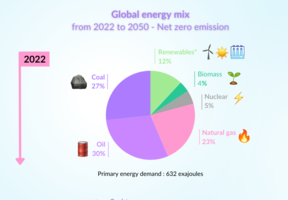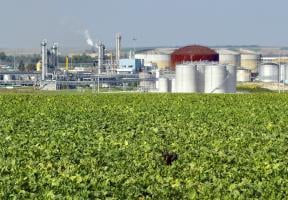Methanation - Biogas in our Waste
10 min read
is naturally produced through the of many different types of animal- and plant-derived organic matter. New biogas plants and even landfills increasingly tap into this little-known energy from waste, using to provide , or automotive .

© THINKSTOCK - Germany has developed large-capacity methanation units.
A Natural Phenomenon
Methanation is an fermentation process whereby putrescible (readily ) matter is broken down by in the absence of oxygen. This process naturally occurs in marshes, where it leads to the production of marsh gas. Methanation produces biogas, a mixture of gases consisting mainly of methane (CH4), which also accounts for over 90% of the content of the fossil fuel natural gas.
Methanation can be applied to any form of naturally fermenting organic waste. Examples include paper and cardboard, food waste and leftovers, agricultural waste, manure and slurry from livestock, and sludge from wastewater treatment plants. Developed in the 1980s, methanation is a booming waste treatment solution across Europe. In 2013, roughly 7 million tons of municipal waste was processed using methanation.
The composition of biogas obtained through methanation is as follows:
- 55 to 70% methane (CH4);
- 30 to 45% carbon dioxide (CO2);
- Small quantities of ammonia (NH3) and sulfide (H2S);
- Solid residue from methanation, or , which can be dried and used as fertilizer.
Commercial-Scale Production
A methanation unit consists of a large, covered tank into which the waste to be treated is deposited. These tanks are called reactors, fermenters or digesters. They operate at a temperature of 35°C, running on some of the biogas produced from the waste. In the newest reactors, methanation takes several days, producing 1 to 10 cubic meters of biogas per cubic meter of waste per day.
The size of biogas production units can vary significantly. A small anaerobic digester on a farm typically has a capacity of about 100 cubic meters. On the other end of the scale, the Penkun plant in Germany can generate up to 20 MW of power using 40 enormous digesters.
Landfills as Powerful Energy Sources
The other main method of producing biogas is through the recovery of landfill gases. Over long periods of time, landfills spontaneously produce methane through a process of fermentation.
In these waste disposal facilities, refuse is compacted and placed in trenches known as cells that are sometimes sealed to give better results. The cells are then covered with several meters of soil. A system of horizontal and vertical pipes run through the cells, the former to collect the biogas produced and the latter to bring the biogas to the surface. This underground fermentation process can take 25 years.
Methane, a harmful greenhouse gas, must be recovered to prevent its release into the atmosphere. Where waste methane is not recovered, it is burned. The carbon dioxide produced in this way is much less damaging than methane.
Biogas’ Many Applications
Before biogas can be used, all traces of hydrogen sulfide - which corrodes metal - must be removed. Hydrogen sulfide is highly toxic when burned as it releases sulfur dioxide (SO2), which can damage both forests (through acid rain) and our lungs.
Biogas can be burned to produce heat, power or both, through , with 170 kWh of power and 340 kWh of heat generated per ton of methanized waste. After all the impurities have been removed, including carbon dioxide, the gas can be fed into the municipal gas network. It can also be used to fuel natural gas vehicles (NGVs) that run on compressed methane. In addition, several European countries have successfully integrated biogas fuel into their mass transit systems.
Biogas, a Valuable Resource for Farms
Extensively developed in Denmark and Germany, biogas digesters can be used on farms to produce energy locally from livestock slurry. In 2010, a total of 5,800 on-farm digesters were already in place in Germany. In March 2013, the French government launched the EMAA plan to improve nitrogen management and develop methanation1. Under the plan, 1,000 digesters should be operating on France’s farms by 2020, compared with just 90 at the end of 2012. Millions of digesters are already up and running in China, India and Nepal.



















